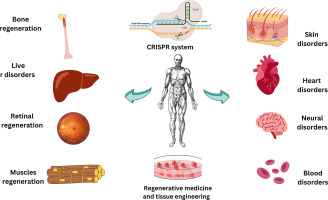
**Introduction to CRISPR**
CRISPR is an innovative mechanism that is altering lives and creating significant impacts in the healthcare domain. CRISPR, representing “Clustered Regularly Interspaced Short Palindromic Repeats,” is observed in prokaryotes—tiny, single-celled entities devoid of organelles. These sequences are embedded in the genomes of prokaryotes, which cluster a cell’s DNA.
As a genomic editing instrument, CRISPR is employed to alter specific DNA segments aimed at addressing serious medical conditions. It is especially effective as it aids the body in fending off viral attacks by assimilating the foreign DNA into its own genome, thereby enabling it to identify and eliminate the virus in subsequent encounters. Notably, when compared to other genomic editing strategies, CRISPR is significantly more accurate and simpler to code, facilitating an easier redesigning of sequences. Unlike other genetic tools that usually depend on a single protein, CRISPR utilizes RNA-guided targeting alongside the Cas9 enzyme.
—
**How CRISPR Works**
CRISPR operates by leveraging a natural defense mechanism discovered in bacteria that enables them to detect and eradicate viral threats. When a virus infiltrates a bacterial cell (a prokaryote), the bacterium preserves a fragment of the invader’s DNA as a genetic “memory” within its genome. This allows the bacterium to recognize and react more efficiently to future infections.
In genomic editing, this mechanism is modified with two essential elements: the Cas9 enzyme, which acts like molecular scissors for cutting DNA, and guide RNA, which directs Cas9 to the precise genetic sequence requiring modification. Once the target DNA is severed, the cell’s inherent repair systems take charge, allowing researchers to implement alterations to the genetic sequence.
In contrast to previous tools that depended on challenging-to-reprogram proteins, CRISPR’s RNA-guided framework is more adaptable, simpler to design, and extremely precise. This straightforwardness and accuracy have enabled CRISPR’s application in medical, agricultural, industrial, and microbiological fields—such as engineering microorganisms to enhance production outputs. Nevertheless, as this article discusses, with increasing abilities arise escalating ethical dilemmas, particularly concerning germline modification and genetic enhancement.
—
**World’s First Patient of a Personalized CRISPR Treatment**
In February 2025, the inaugural personalized CRISPR treatment was administered to a newborn named KJ to address a deficiency in Carbamoyl Phosphate Synthetase 1 (CPS1)—an enzyme crucial for converting ammonia (produced during protein metabolism) into urea. A team headed by Dr. Rebecca Ahrens-Nicklas and Dr. Kiran Musunuru at the Children’s Hospital of Philadelphia formulated this treatment following years of research in genetic editing and partnerships with various clinicians.
Their research concentrated on conditions impacting the urea cycle, which results in hazardous ammonia accumulation, damaging organs such as the brain and liver. They customized the therapy specifically for KJ’s variant of CPS1 deficiency based on preclinical investigations of related variants.
Previously, the only CRISPR therapies authorized by the U.S. FDA have targeted more prevalent illnesses like sickle cell disease and beta thalassemia, which impact tens or hundreds of thousands of patients. In KJ’s instance, his treatment was devised within six months after birth, specifically targeting his CPS1 variant. The team developed a base editing approach delivered via lipid nanoparticles to his liver to rectify the defective enzyme.
The February treatment was the initial dose of three; KJ received the subsequent two doses in March and April 2025. As of his last injection, he has not encountered any severe side effects, displays improved tolerance to dietary protein, and requires a reduced amount of medication to regulate ammonia levels. While he will need ongoing observation, Ahrens-Nicklas notes that the initial results are encouraging.
—
**Ethical Considerations of CRISPR**
As with any transformative technology, CRISPR prompts intricate ethical dilemmas. While its main aim is to modify somatic cells to treat ailments, it can also be applied to gametes, venturing into the contentious area of germline editing. Modifying DNA that will be passed on to subsequent generations is frequently deemed unethical—especially when executed for enhancing features rather than addressing health issues.
In light of these concerns, scientists have temporarily halted germline editing until its ethical and societal ramifications are more thoroughly understood. The unpredictability of genetic modifications and the permanence of these alterations across generations provoke significant inquiries about where to establish boundaries. What originated as a pioneering concept has evolved into a formidable reality, igniting discussions over who has the authority to determine its limitations.
The high costs and sophisticated infrastructure associated with CRISPR render it more attainable in affluent, developed regions—especially in the West. As treatments continue to be costly, access becomes restricted to the wealthy, exacerbating socioeconomic disparities. The potential for utilizing CRISPR to engineer so-called